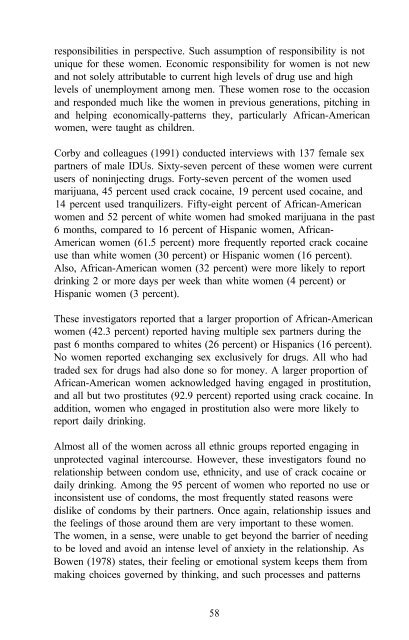The Context of HIV Risk Among Drug Users and Their Sexual Partners
The Context of HIV Risk Among Drug Users and Their Sexual Partners
The Context of HIV Risk Among Drug Users and Their Sexual Partners
You also want an ePaper? Increase the reach of your titles
YUMPU automatically turns print PDFs into web optimized ePapers that Google loves.
esponsibilities in perspective. Such assumption <strong>of</strong> responsibility is not<br />
unique for these women. Economic responsibility for women is not new<br />
<strong>and</strong> not solely attributable to current high levels <strong>of</strong> drug use <strong>and</strong> high<br />
levels <strong>of</strong> unemployment among men. <strong>The</strong>se women rose to the occasion<br />
<strong>and</strong> responded much like the women in previous generations, pitching in<br />
<strong>and</strong> helping economically-patterns they, particularly African-American<br />
women, were taught as children.<br />
Corby <strong>and</strong> colleagues (1991) conducted interviews with 137 female sex<br />
partners <strong>of</strong> male IDUs. Sixty-seven percent <strong>of</strong> these women were current<br />
users <strong>of</strong> noninjecting drugs. Forty-seven percent <strong>of</strong> the women used<br />
marijuana, 45 percent used crack cocaine, 19 percent used cocaine, <strong>and</strong><br />
14 percent used tranquilizers. Fifty-eight percent <strong>of</strong> African-American<br />
women <strong>and</strong> 52 percent <strong>of</strong> white women had smoked marijuana in the past<br />
6 months, compared to 16 percent <strong>of</strong> Hispanic women, African-<br />
American women (61.5 percent) more frequently reported crack cocaine<br />
use than white women (30 percent) or Hispanic women (16 percent).<br />
Also, African-American women (32 percent) were more likely to report<br />
drinking 2 or more days per week than white women (4 percent) or<br />
Hispanic women (3 percent).<br />
<strong>The</strong>se investigators reported that a larger proportion <strong>of</strong> African-American<br />
women (42.3 percent) reported having multiple sex partners during the<br />
past 6 months compared to whites (26 percent) or Hispanics (16 percent).<br />
No women reported exchanging sex exclusively for drugs. All who had<br />
traded sex for drugs had also done so for money. A larger proportion <strong>of</strong><br />
African-American women acknowledged having engaged in prostitution,<br />
<strong>and</strong> all but two prostitutes (92.9 percent) reported using crack cocaine. In<br />
addition, women who engaged in prostitution also were more likely to<br />
report daily drinking.<br />
Almost all <strong>of</strong> the women across all ethnic groups reported engaging in<br />
unprotected vaginal intercourse. However, these investigators found no<br />
relationship between condom use, ethnicity, <strong>and</strong> use <strong>of</strong> crack cocaine or<br />
daily drinking. <strong>Among</strong> the 95 percent <strong>of</strong> women who reported no use or<br />
inconsistent use <strong>of</strong> condoms, the most frequently stated reasons were<br />
dislike <strong>of</strong> condoms by their partners. Once again, relationship issues <strong>and</strong><br />
the feelings <strong>of</strong> those around them are very important to these women.<br />
<strong>The</strong> women, in a sense, were unable to get beyond the barrier <strong>of</strong> needing<br />
to be loved <strong>and</strong> avoid an intense level <strong>of</strong> anxiety in the relationship. As<br />
Bowen (1978) states, their feeling or emotional system keeps them from<br />
making choices governed by thinking, <strong>and</strong> such processes <strong>and</strong> patterns<br />
58
















